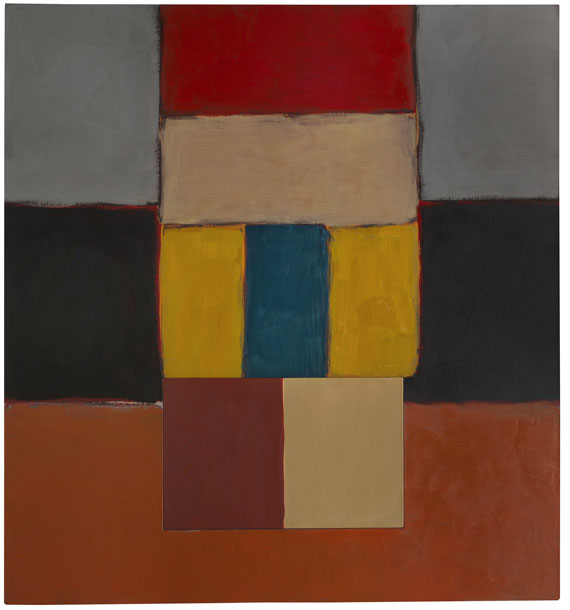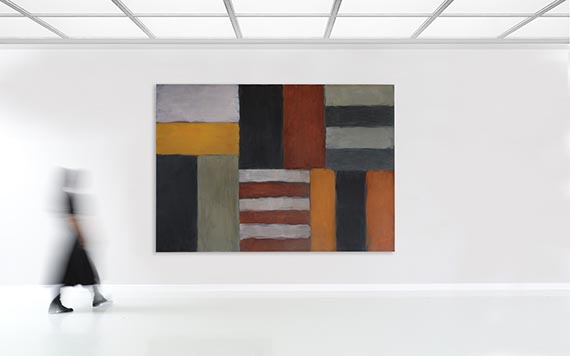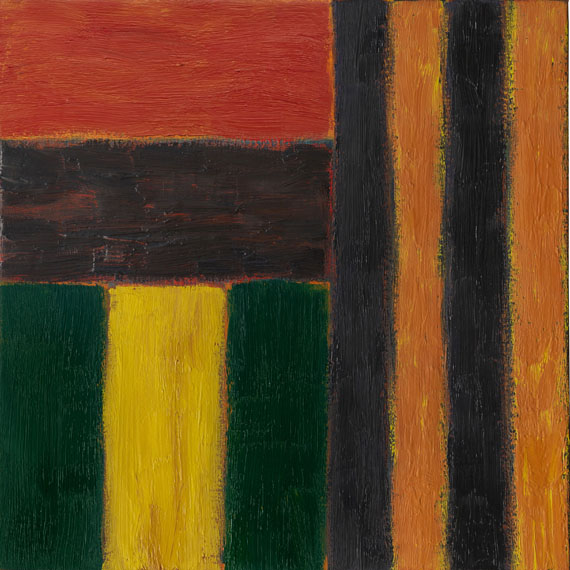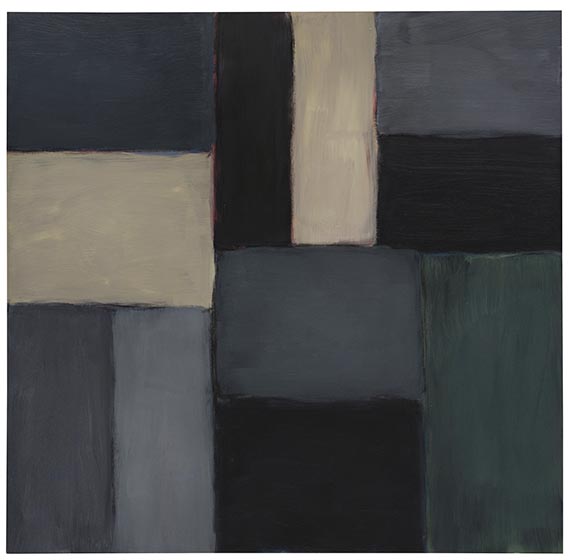51
Sean Scully
Untitled, 2007.
Oil on aluminum
Estimate:
€ 150,000 - 250,000
$ 165,000 - 275,000
Untitled. 2007.
Oil on aluminum.
Signed, dated "12.25.07", and inscribed "Ingrid" on the reverse. 71 x 81.5 cm (27.9 x 32 in).
• The year this work was created, the artist used aluminum as a substrate for his sensual and complex oil paintings for the first time.
• Fascinating contrasts: the metal's hard, cold materiality, the warm, earthy colors and the sensual, matt-glossy surface.
• Similar paintings from the significant year 2007 can be found at, among others, the Museum of Fine Arts Bern, the Albertina in Vienna and the Centre Pompidou, Paris.
• Important paintings from the 2000s are on display in museums around the world, among them Tate London, the Art Institute of Chicago, the Metropolitan Museum and the Museum of Modern Art, New York.
PROVENANCE: Private collection, Southern Germany (acquired from the artist in 2008).
Acquired by the present owner from the above.
"I am just starting to work with metal (aluminum) panels. I love canvas and wood, but applying an old medium (oil paint) to a contemporary metal will break up the feeling of nostalgia and that intrigues me."
Sean Scully, September 5, 2007, quoted from: Kelly Grovier (ed.), Inner, Berlin 2018, p. 224.
Called up: December 6, 2024 - ca. 18.40 h +/- 20 min.
Oil on aluminum.
Signed, dated "12.25.07", and inscribed "Ingrid" on the reverse. 71 x 81.5 cm (27.9 x 32 in).
• The year this work was created, the artist used aluminum as a substrate for his sensual and complex oil paintings for the first time.
• Fascinating contrasts: the metal's hard, cold materiality, the warm, earthy colors and the sensual, matt-glossy surface.
• Similar paintings from the significant year 2007 can be found at, among others, the Museum of Fine Arts Bern, the Albertina in Vienna and the Centre Pompidou, Paris.
• Important paintings from the 2000s are on display in museums around the world, among them Tate London, the Art Institute of Chicago, the Metropolitan Museum and the Museum of Modern Art, New York.
PROVENANCE: Private collection, Southern Germany (acquired from the artist in 2008).
Acquired by the present owner from the above.
"I am just starting to work with metal (aluminum) panels. I love canvas and wood, but applying an old medium (oil paint) to a contemporary metal will break up the feeling of nostalgia and that intrigues me."
Sean Scully, September 5, 2007, quoted from: Kelly Grovier (ed.), Inner, Berlin 2018, p. 224.
Called up: December 6, 2024 - ca. 18.40 h +/- 20 min.
Layers of stripes
For over 50 years, Sean Scully's intriguing oeuvre has been dominated by compositions of stripes in various colors. They run vertically and horizontally and vary in width and length, while the artist also fills his paintings' pictorial surfaces with rectangular color fields. The first step Scully takes is to divide and organize the surface that is to be painted, a precise arrangement of stripes and color fields. Drawing on an almost infinite wealth of composition options, Scully initially subdivides the rectangular form of the pictorial surface into several more minor rectangular elements. In his later works, the division aspect becomes considerably less strict: Instead of using a ruler, he draws the lines by hand. Scully then applies the paint with a broad brush in multiple layers, sometimes overlapping and sometimes impasto. In the present work, Scully uses this layering to create a variety of shades of red: no two shades of red are the same, an effect created by concealed underpainting. We find beneath the visible surface colors hues of blue, gray-green, light yellow, violet, and brown. Narrow stripes of color gleam from the blurred edges and transitions between the individual color fields, making the picture's surface shimmer and vibrate, filling it with life. “There are no simple colors in my work.. there are no whites, no reds. Colors are always subverted by the colors underneath, so when you're looking at something, you are never quite sure what you're looking at” (Sean Scully, quoted from Hossein Amirsadeghi/Maryam Homayoun Eisler (eds.), Sanctuary: Britain's Artists and their Studios, London, 2011, p. 112).
From canvas to aluminum
Sean Scully's artistic approach has remained the same over the years, although his painting is constantly subject to development and change. After initial artistic experiments with 'floating' aluminum panels mounted on the wall at 90° angles in the 1990s, the artist discovered metal, an unconventional contemporary material suitable for his surface paintings, in 2007. In contrast to canvas, the rugged aluminum with a smooth surface finish does not allow the paint to 'breathe'; instead, it rests on the surface and, unlike the case with canvas works, is not absorbed by the substrate. In combination with the soft gloss of the oil paint, the metallic surface lends the work an entirely new aesthetic quality. Depending on the incidence of light, the expressiveness of the respective areas of color and their surface texture changes and, in combination with the warm colors used here, results in a highly sensual opulence.
"Full of emotion"
In the present work, Scully pushed the envelope even further than in works from the 1990s. In this case, the formal framework barely holds the composition together. The black surface provides stability. However, the individual color bands differ in length, the broad brushstroke blurs the edges, and here and there, the artist lets the brush touch the surface 'too early' or 'too late' so that the application of paint contradicts the previously conceived geometric division of the pictorial surface in a very sensual way. Rigor and precision have to make way for gentle transitions, a particularly painterly style, and the energy and emotions Scully sets free when painting. "I am convinced that abstraction is and was there to embody deep emotion," explains the artist (quoted from Kelly Grovier (ed.), Inner, Berlin 2018, p. 104). Inspired by the Abstract Expressionists, including Mark Rothko, Scully discovered his unmistakable visual language, a deeply felt, poetically charged abstraction: "Newman tried to make a space that was spiritually charged, and that is what I try to do in my work too." (S. Scully, quoted from: Florence Ingleby (ed.), Sean Scully. Resistance and Persistence. Selected Writings, London 2006, p. 90)
Ai Weiwei also comments on this sentimental side of Scully's painting: "You could see his expression and passion in every piece, and that is something that has never changed. His works have always been full of emotion, and you can see clearly where intention and form intersect." (Ai Weiwei, quoted from: Kelly Grovier (ed.), Sean Scully. Bricklayer of the Soul, Ostfildern 2015, p. 55). [CH]
For over 50 years, Sean Scully's intriguing oeuvre has been dominated by compositions of stripes in various colors. They run vertically and horizontally and vary in width and length, while the artist also fills his paintings' pictorial surfaces with rectangular color fields. The first step Scully takes is to divide and organize the surface that is to be painted, a precise arrangement of stripes and color fields. Drawing on an almost infinite wealth of composition options, Scully initially subdivides the rectangular form of the pictorial surface into several more minor rectangular elements. In his later works, the division aspect becomes considerably less strict: Instead of using a ruler, he draws the lines by hand. Scully then applies the paint with a broad brush in multiple layers, sometimes overlapping and sometimes impasto. In the present work, Scully uses this layering to create a variety of shades of red: no two shades of red are the same, an effect created by concealed underpainting. We find beneath the visible surface colors hues of blue, gray-green, light yellow, violet, and brown. Narrow stripes of color gleam from the blurred edges and transitions between the individual color fields, making the picture's surface shimmer and vibrate, filling it with life. “There are no simple colors in my work.. there are no whites, no reds. Colors are always subverted by the colors underneath, so when you're looking at something, you are never quite sure what you're looking at” (Sean Scully, quoted from Hossein Amirsadeghi/Maryam Homayoun Eisler (eds.), Sanctuary: Britain's Artists and their Studios, London, 2011, p. 112).
From canvas to aluminum
Sean Scully's artistic approach has remained the same over the years, although his painting is constantly subject to development and change. After initial artistic experiments with 'floating' aluminum panels mounted on the wall at 90° angles in the 1990s, the artist discovered metal, an unconventional contemporary material suitable for his surface paintings, in 2007. In contrast to canvas, the rugged aluminum with a smooth surface finish does not allow the paint to 'breathe'; instead, it rests on the surface and, unlike the case with canvas works, is not absorbed by the substrate. In combination with the soft gloss of the oil paint, the metallic surface lends the work an entirely new aesthetic quality. Depending on the incidence of light, the expressiveness of the respective areas of color and their surface texture changes and, in combination with the warm colors used here, results in a highly sensual opulence.
"Full of emotion"
In the present work, Scully pushed the envelope even further than in works from the 1990s. In this case, the formal framework barely holds the composition together. The black surface provides stability. However, the individual color bands differ in length, the broad brushstroke blurs the edges, and here and there, the artist lets the brush touch the surface 'too early' or 'too late' so that the application of paint contradicts the previously conceived geometric division of the pictorial surface in a very sensual way. Rigor and precision have to make way for gentle transitions, a particularly painterly style, and the energy and emotions Scully sets free when painting. "I am convinced that abstraction is and was there to embody deep emotion," explains the artist (quoted from Kelly Grovier (ed.), Inner, Berlin 2018, p. 104). Inspired by the Abstract Expressionists, including Mark Rothko, Scully discovered his unmistakable visual language, a deeply felt, poetically charged abstraction: "Newman tried to make a space that was spiritually charged, and that is what I try to do in my work too." (S. Scully, quoted from: Florence Ingleby (ed.), Sean Scully. Resistance and Persistence. Selected Writings, London 2006, p. 90)
Ai Weiwei also comments on this sentimental side of Scully's painting: "You could see his expression and passion in every piece, and that is something that has never changed. His works have always been full of emotion, and you can see clearly where intention and form intersect." (Ai Weiwei, quoted from: Kelly Grovier (ed.), Sean Scully. Bricklayer of the Soul, Ostfildern 2015, p. 55). [CH]
51
Sean Scully
Untitled, 2007.
Oil on aluminum
Estimate:
€ 150,000 - 250,000
$ 165,000 - 275,000
Buyer's premium, taxation and resale right compensation for Sean Scully "Untitled"
This lot can be purchased subject to differential or regular taxation, artist‘s resale right compensation is due.
Differential taxation:
Hammer price up to 800,000 €: herefrom 32 % premium.
The share of the hammer price exceeding 800,000 € is subject to a premium of 27 % and is added to the premium of the share of the hammer price up to 800,000 €.
The share of the hammer price exceeding 4,000,000 € is subject to a premium of 22 % and is added to the premium of the share of the hammer price up to 4,000,000 €.
The buyer's premium contains VAT, however, it is not shown.
Regular taxation:
Hammer price up to 800,000 €: herefrom 27 % premium.
The share of the hammer price exceeding 800,000 € is subject to a premium of 21% and is added to the premium of the share of the hammer price up to 800,000 €.
The share of the hammer price exceeding 4,000,000 € is subject to a premium of 15% and is added to the premium of the share of the hammer price up to 4,000,000 €.
The statutory VAT of currently 19 % is levied to the sum of hammer price and premium. As an exception, the reduced VAT of 7 % is added for printed books.
We kindly ask you to notify us before invoicing if you wish to be subject to regular taxation.
Calculation of artist‘s resale right compensation:
For works by living artists, or by artists who died less than 70 years ago, a artist‘s resale right compensation is levied in accordance with Section 26 UrhG:
4 % of hammer price from 400.00 euros up to 50,000 euros,
another 3 % of the hammer price from 50,000.01 to 200,000 euros,
another 1 % for the part of the sales proceeds from 200,000.01 to 350,000 euros,
another 0.5 % for the part of the sale proceeds from 350,000.01 to 500,000 euros and
another 0.25 % of the hammer price over 500,000 euros.
The maximum total of the resale right fee is EUR 12,500.
The artist‘s resale right compensation is VAT-exempt.
Differential taxation:
Hammer price up to 800,000 €: herefrom 32 % premium.
The share of the hammer price exceeding 800,000 € is subject to a premium of 27 % and is added to the premium of the share of the hammer price up to 800,000 €.
The share of the hammer price exceeding 4,000,000 € is subject to a premium of 22 % and is added to the premium of the share of the hammer price up to 4,000,000 €.
The buyer's premium contains VAT, however, it is not shown.
Regular taxation:
Hammer price up to 800,000 €: herefrom 27 % premium.
The share of the hammer price exceeding 800,000 € is subject to a premium of 21% and is added to the premium of the share of the hammer price up to 800,000 €.
The share of the hammer price exceeding 4,000,000 € is subject to a premium of 15% and is added to the premium of the share of the hammer price up to 4,000,000 €.
The statutory VAT of currently 19 % is levied to the sum of hammer price and premium. As an exception, the reduced VAT of 7 % is added for printed books.
We kindly ask you to notify us before invoicing if you wish to be subject to regular taxation.
Calculation of artist‘s resale right compensation:
For works by living artists, or by artists who died less than 70 years ago, a artist‘s resale right compensation is levied in accordance with Section 26 UrhG:
4 % of hammer price from 400.00 euros up to 50,000 euros,
another 3 % of the hammer price from 50,000.01 to 200,000 euros,
another 1 % for the part of the sales proceeds from 200,000.01 to 350,000 euros,
another 0.5 % for the part of the sale proceeds from 350,000.01 to 500,000 euros and
another 0.25 % of the hammer price over 500,000 euros.
The maximum total of the resale right fee is EUR 12,500.
The artist‘s resale right compensation is VAT-exempt.




 Lot 51
Lot 51 




